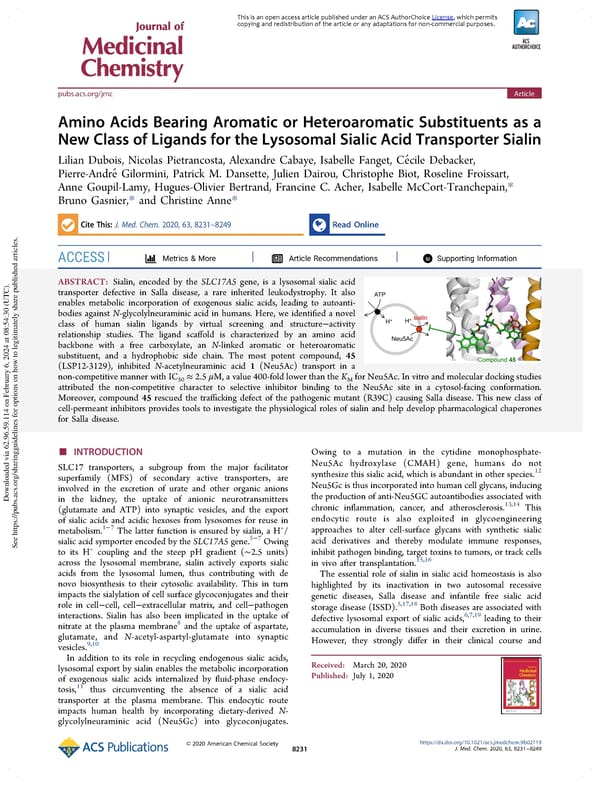Amino Acids Bearing Aromatic or Heteroaromatic Substituents as a New Class of Ligands for the Lysosomal Sialic Acid Transporter Sialin
This is an open access article published under an ACS AuthorChoice License, which permits copying and redistribution of the article or any adaptations for non-commercial purposes. pubs.acs.org/jmc Article Amino Acids Bearing Aromatic or Heteroaromatic Substituents as a NewClassofLigandsfortheLysosomalSialicAcidTransporterSialin ́ Lilian Dubois, Nicolas Pietrancosta, Alexandre Cabaye, Isabelle Fanget, Cecile Debacker, Pierre-André Gilormini, Patrick M. Dansette, Julien Dairou, Christophe Biot, Roseline Froissart, Anne Goupil-Lamy, Hugues-Olivier Bertrand, Francine C. Acher, Isabelle McCort-Tranchepain,* Bruno Gasnier,* and Christine Anne* Cite This: J. Med. Chem. 2020, 63, 8231−8249 Read Online Metrics & More Article Recommendations sı Supporting Information ACCESS * ABSTRACT: Sialin, encoded by the SLC17A5 gene, is a lysosomal sialic acid transporter defective in Salla disease, a rare inherited leukodystrophy. It also enables metabolic incorporation of exogenous sialic acids, leading to autoanti- bodies against N-glycolylneuraminic acid in humans. Here, we identified a novel class of human sialin ligands by virtual screening and structure−activity relationship studies. The ligand scaffold is characterized by an amino acid backbone with a free carboxylate, an N-linked aromatic or heteroaromatic substituent, and a hydrophobic side chain. The most potent compound, 45 (LSP12-3129), inhibited N-acetylneuraminic acid 1 (Neu5Ac) transport in a non-competitive manner with IC ≈2.5μM,avalue400-foldlowerthantheK forNeu5Ac.Invitroandmoleculardockingstudies 50 M attributed the non-competitive character to selective inhibitor binding to the Neu5Ac site in a cytosol-facing conformation. Moreover, compound 45 rescued the trafficking defect of the pathogenic mutant (R39C) causing Salla disease. This new class of cell-permeant inhibitors provides tools to investigate the physiological roles of sialin and help develop pharmacological chaperones for Salla disease. ■ INTRODUCTION Owing to a mutation in the cytidine monophosphate- SLC17 transporters, a subgroup from the major facilitator Neu5Ac hydroxylase (CMAH) gene, humans do not superfamily (MFS) of secondary active transporters, are synthesize this sialic acid, which is abundant in other species.12 involved in the excretion of urate and other organic anions Neu5Gcisthus incorporated into human cell glycans, inducing Downloaded via 62.96.59.114 on February 6, 2024 at 08:54:30 (UTC).in the kidney, the uptake of anionic neurotransmitters the production of anti-Neu5GC autoantibodies associated with 13,14 (glutamate and ATP) into synaptic vesicles, and the export chronic inflammation, cancer, and atherosclerosis. This of sialic acids and acidic hexoses from lysosomes for reuse in endocytic route is also exploited in glycoengineering 1−7 + approaches to alter cell-surface glycans with synthetic sialic metabolism. The latter function is ensured by sialin, a H / 5−7 acid derivatives and thereby modulate immune responses, See https://pubs.acs.org/sharingguidelines for options on how to legitimately share published articles.sialic acid symporter encoded by the SLC17A5 gene.Owing to its H+ coupling and the steep pH gradient (∼2.5 units) inhibit pathogen binding, target toxins to tumors, or track cells across the lysosomal membrane, sialin actively exports sialic in vivo after transplantation.15,16 acids from the lysosomal lumen, thus contributing with de The essential role of sialin in sialic acid homeostasis is also novo biosynthesis to their cytosolic availability. This in turn highlighted by its inactivation in two autosomal recessive impacts the sialylation of cell surface glycoconjugates and their genetic diseases, Salla disease and infantile free sialic acid role in cell−cell, cell−extracellular matrix, and cell−pathogen 5,17,18 storage disease (ISSD). Both diseases are associated with interactions. Sialin has also been implicated in the uptake of defective lysosomal export of sialic acids,6,7,19 leading to their 8 nitrate at the plasma membrane and the uptake of aspartate, accumulation in diverse tissues and their excretion in urine. glutamate, and N-acetyl-aspartyl-glutamate into synaptic However, they strongly differ in their clinical course and 9,10 vesicles. In addition to its role in recycling endogenous sialic acids, Received: March 20, 2020 lysosomal export by sialin enables the metabolic incorporation Published: July 1, 2020 of exogenous sialic acids internalized by fluid-phase endocy- tosis,11 thus circumventing the absence of a sialic acid transporter at the plasma membrane. This endocytic route impacts human health by incorporating dietary-derived N- glycolylneuraminic acid (Neu5Gc) into glycoconjugates. ©2020 American Chemical Society https://dx.doi.org/10.1021/acs.jmedchem.9b02119 8231 J. Med. Chem. 2020, 63, 8231−8249
 Amino Acids Bearing Aromatic or Heteroaromatic Substituents as a New Class of Ligands for the Lysosomal Sialic Acid Transporter Sialin Page 2
Amino Acids Bearing Aromatic or Heteroaromatic Substituents as a New Class of Ligands for the Lysosomal Sialic Acid Transporter Sialin Page 2